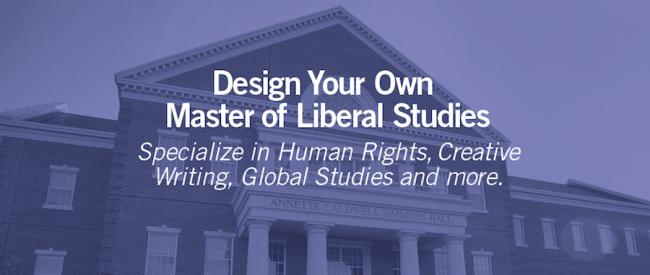Reverend Randall Foster, priest-in-charge at St. Michael Anglican Church in Richland Hills, Texas, has spent many long hours recently reading Homer and Darwin, Adam Smith and Karl Marx, Freud and Jung, Charlotte Bronte and Anne Lamott. He has also studied the paintings of artists such as Botticelli and Rothko.
“Not only have I studied these great individuals, I have constantly been encouraged to think about what their works and their lives mean–both to me and to the people around me.”
Foster is a student in SMU’s Master of Liberal Studies (MLS), a program that allows students to pursue a higher education that allows more choice and more opportunity for interdisciplinary study. Students can choose from a concentration including but not limited to: creative writing, humanities, and global studies, sustaining the environment, communication, and media and technology.

Students can even design a study of their own. Reverend Foster himself has chosen a self-designed concentration designated ‘Intellectual History’.
A cross-disciplinary program calling upon material from History, Philosophy, Literature, Art History, Psychology, Sociology and Anthropology, Foster’s thesis examines novels by authors such as Bronte and Dickens and also paintings by the Pre-Raphaelite painter John Everett Millais. This particular course of study focuses on class and social status in the mid-Victorian period in England and particularly as they relate to young women of lesser gentry and upper class.
Reverend Foster says he initially became interested in the program because he was looking for a new intellectual challenge.
“After ten years of full-time teaching and ministry, I was in somewhat of a rut,” Foster said. “I felt that I had depleted my intellectual resources a bit and I wanted to feel that sense of excitement again.”
Executive Coordinator of the program Michele Mrak, says that many of the MLS program students feel this way when they decide to join the program.
“Whether people decide to change careers or just want an extra hobby besides their career, the MLS program is a great segway to intellectual and personal growth,” said Mrak.
Foster adds, “I am a much better teacher, pastor, preacher and pastoral counselor but more importantly I believe I am a better person for having shared this experience with excellent, caring faculty and student colleagues.”
The Master of Liberal Studies program has been around for nearly 40 years. Mrak says that one of the most beneficial aspects of the program is that it is customizable and flexible according to each student’s schedule. Another surprising detail is that the program is not simply for college graduates. “Anyone from 22 years old to 82 years old have gone through the program,” said Mrak.
Bonnie Bazley, assistant to SMU’s vice president of student affairs, said that by far the most gratifying aspect of the program lies outside the classroom.
“My favorite part by far is getting to know the people I’ve met in my classes,” she said.
The MLS program tuition is $568 per credit hour or $1704 for a 3-credit course in the Spring/Summer Term. In the fall tuition runs $596 per credit hour or $1788 for a 3-credit course. There are no additional expenses other than the textbooks and parking which students are responsible for financing. Students also must complete the two foundational courses entitled HUMN 6316/The Human Experience: An Introduction to Liberal Studies, and another designated writing intensive course of the student’s choosing: (HUMN 6370, SCCL 6305, HUMN 6397, or HUMN 6309). These courses must be completed in order for students to be granted access to any additional courses. There are about 15 students per class, similar to the structure of an SMU undergraduate class in order to give each student the appropriate amount of attention. In order to receive the degree, students must complete 12 courses within six years after beginning the program. The strongest applicants of the program usually have a GPA of about a 2.7 – 3.5 from their undergraduate institution.
Tamera Hurdle, manager of Operations at the McFarlin Auditorium, will be beginning the MLS program this fall. Hurdle says she has been interested in designing her own self-designed curriculum since she was an undergrad in the 90s.
“Just about every class did and still does look fascinating to me,” said Hurdle. “I look forward to strengthening my skills as a writer as well as to explore new topics and expand my knowledge in areas I am familiar with.”
The program also receives high marks from the professors who teach it. Gary Swaim is a professor specializing in the Human Experience with courses such as Creating Poetry, Creating Short Fiction, Creating the Novel, Creating the Memoir, Creating the Screenplay, and Creativity: Historical and Personal. Swaim says he has been very impressed with the work his students have turned out over the years.
“I have one student now on her third published novel, another on his second novel in a series, and many others with poetry published in very respectable journals,” said Swaim.
Swaim says that no matter how different his students are in terms of their background, the students all possess the same remarkable dedication to their work.
“They know just exactly why they are in our program, and they are happy as they know their work will be critiqued by their colleagues and by their professors fairly, encouragingly, and to their benefits,” said Swaim.










